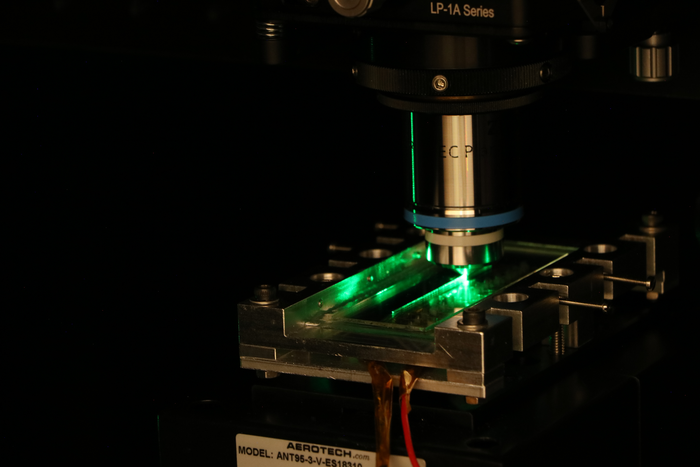Sapphire fibre could enable cleaner energy and air-travel
Researchers have developed a sensor made of sapphire fiber that can tolerate extreme temperatures with efficiency and emission reduction.

[Apr. 24, 2022: Clea Boorman, University of Oxford]
A sapphire optical fibre – a thread of industrially grown sapphire less than half a millimetre thick – which can withstand temperatures over 2000°C. (CREDIT: Julian Fells/University of Oxford)
Oxford University researchers have developed a sensor made of sapphire fibre that can tolerate extreme temperatures, with the potential to enable significant improvements in efficiency and emission reduction in aerospace and power generation.
The work, published in the journal Optics Express, uses a sapphire optical fibre – a thread of industrially grown sapphire less than half a millimetre thick – which can withstand temperatures over 2000°C. When light is injected onto one end of the sapphire fibre, some is reflected back from a point along the fibre which has been modified to be sensitive to temperature (known as a Bragg grating). The wavelength (colour) of this reflected light is a measure of the temperature at that point.
The research resolves a 20-year-old problem with existing sensors that, whilst the sapphire fibre seems very thin, in comparison to the wavelength of light it is huge. This means that the light can take many different paths along the sapphire fibre, which results in many different wavelengths being reflected at once. The researchers overcame this problem by writing a channel along the length of the fibre, such that the light is contained within a tiny cross-section, one-hundredth of a millimetre in diameter. With this approach, they were able to make a sensor reflecting predominantly a single wavelength of light.
Sapphire optical fibre one-hundredth of a millimetre in diameter. (CREDIT: Julian Fells/University of Oxford)
Related Stories
The initial demonstration was on a short length of sapphire fibre 1 cm long, but the researchers predict that lengths of up to several metres will be possible, with a number of separate sensors along this length. This would enable temperature measurements to be made throughout a jet engine, for example. Using this data to adapt engine conditions in-flight has the potential to significantly reduce nitrogen oxide emissions and improve overall efficiency, reducing the environmental impact. The sapphire’s resistance to radiation also gives applications in the space and fusion power industries.
Research team member Dr Mohan Wang, Department of Engineering Science, University of Oxford said:
‘The sensors are fabricated using a high-power laser with extremely short pulses and a significant hurdle was preventing the sapphire from cracking during this process.’
Sapphire optical fibre. (CREDIT: Julian Fells/University of Oxford)
The work is part of a £1.2M EPSRC Fellowship Grant held by Dr Julian Fells at the University of Oxford’s Department of Engineering Science and was carried out in partnership with Rolls-Royce, the UK Atomic Energy Authority (Remote Applications in Challenging Environments – RACE), Cranfield University, Halliburton and MDA Space and Robotics.
Mark Jefferies, Chief of University Research Liaison at Rolls-Royce plc said:
‘This is exciting news and yet another important scientific achievement resulting from our long-standing partnership with Oxford University. This fundamental research could in time enable more efficient and accurate multi-point temperature measurement in harsh environments, improving control, efficiency, and safety. We look forward to working with the University of Oxford to explore its potential.’
Rob Skilton, Head of Research at RACE, UK Atomic Energy Authority said:
‘These sapphire optical fibres will have many different potential applications within the extreme environments of a fusion energy powerplant. This technology has the potential to significantly increase the capabilities of future sensor and robotic maintenance systems in this sector, helping UKAEA in its mission to deliver safe, sustainable, low carbon fusion power to the grid.’
Dr Fells, who is leading the research, said:
‘We are very grateful to the UK Engineering and Physical Sciences Research Council (EPSRC) for supporting this work and to the reviewers who saw the potential for the challenging work we proposed. We are now working with our partners to further develop the technology to the point where it can be integrated into suitable infrastructure.’
Note: Materials provided above by University of Oxford. Content may be edited for style and length.
Like these kind of feel good stories? Get the Brighter Side of News' newsletter.
Tags: #New_Innovations, #Green_Good_News, #Sapphire, #Clean_Energy, #Sensors, #Research, #Optical_Thread, #Science, #The_Brighter_Side_of_News
Joseph Shavit
Head Science News Writer | Communicating Innovation & Discovery
Based in Los Angeles, Joseph Shavit is an accomplished science journalist, head science news writer and co-founder at The Brighter Side of News, where he translates cutting-edge discoveries into compelling stories for a broad audience. With a strong background spanning science, business, product management, media leadership, and entrepreneurship, Joseph brings a unique perspective to science communication. His expertise allows him to uncover the intersection of technological advancements and market potential, shedding light on how groundbreaking research evolves into transformative products and industries.



